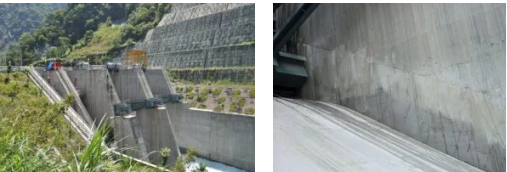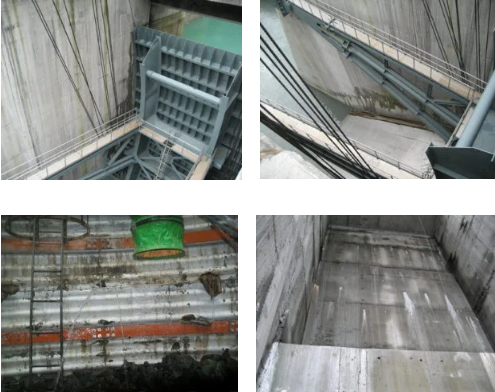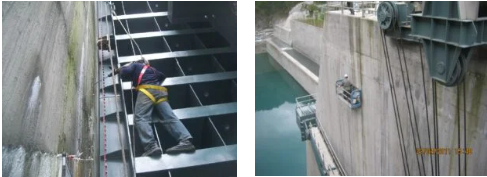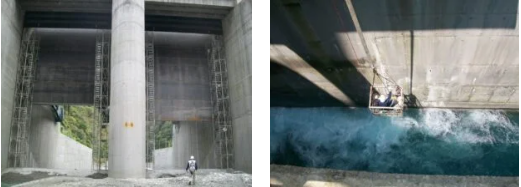
REINFORCEMENT TECHNOLOGY FOR COMPLEX DAM LEAKAGE
Dam structure grout leak-proofing
1. Project Background
A dam spillway gate rail groove, diversion pier wall, sand discharge channel water retaining end wall, etc., had different forms and scales of leakage.
In order to maintain the long-term use safety of the dam, the management unit had specially compiled a budget to recruit a professional engineering team to carry out leakage stop and reinforcement work.
After accepting the commission, the company put forward a repair concept for the leakage and plugging work, and after each unit passed the plans, the relevant site operations were performed.
―
2. Solution
The main leakage situation of this project was divided into 3 zones and 6 types. According to the leakage conditions, the planning solution was as follows:
(1) Water seepage in construction joints or cracks. The 45-degree oblique hole pouring method was combined with two-stage polyurethane resin pouring leak-proofing reinforcement method.
Use of self-expanding resin for temporary water seepage plugging in the first stage, and then grout the original holes with non-expanding resin to facilitate long-term leakage prevention and reinforcement.
(2) According to the structural characteristics, choose elastic non-expanding and rigid non-expanding polyurethane resin as the long-term leak-proof and reinforcing grout material.
(3) When the test finds that there are voids inside the structure or the interface of the steel lining, cement-based or resin-based grout should be used to fill them in accordance with their characteristics.
(4) When damp seepage is encountered but the cracked area cannot be clearly identified, a cement-based penetrating crystalline waterproofing agent to be used for full coating on the front surface.
(5) The bolt holes and primary holes where water seepage occurs are to be filled with resin under pressure for leakage prevention.
(6) All grouting holes and non-leaking holes should be filled and repaired with quick-setting cement or resin mortar.
―
3. Works Design
The main leakage locations of this project were divided into 3 blocks:
(1) Downstream of the rail groove of the spillway gate. The judgment of the leakage path was that it extended from the secondary concrete pouring surface of the gate groove to downstream of the gate.It was planned to adopt the polyurethane resin grouting method. Fully grout the construction joints to completely solve the leakage problem.
(2) The steel lining interface downstream of the diversion pier wall. It was judged that the seepage water was flowing through the interface between the steel lining and the dam structure and extended to the localized construction joints.It was planned to inject a sealing surface at the interface between the steel lining and the gate and along the upper end of the steel lining respectively, and to find the gap between the steel lining and the structure for grout filling with the percussion vibration detection method.
(3) Sand discharge channel retaining walls. Study the seepage through construction joints and bolt holes of different scales.
Plan: to coat cement matrix permeable waterproofing agent on the upstream surface of the wall to block the seepage path; and polyurethane resin leak-proof pressure grouting to be carried out at the construction joints and bolt holes with obvious water seepage downstream of the wall.
―
4. Works Process
Because of similar dam repair work, the company had had a lot of experience since 1993, and the construction process went smoothly.However, the leakage locations of this project were scattered and the structure was relatively steep.
During the works, the scaffolding area reached more than one thousand square meters, and the works had to be coordinated with the suspension operation, which was more time-consuming.
In addition, because the dam had been in operation for a period of time, there was a lot of silt and sediments in the cracks, which made cleaning up more complicated. The rest of the procedures were performed in accordance with the standard operating procedures, and no abnormalities were encountered.
―
5. Results
Polyurethane resin was introduced from Germany to Taiwan in 1992 and has been used for engineering leak-proof reinforcement for 30 years.
In this project, our company followed the standard operating procedures, using self-expanding resin and elastic, rigid non-expanding resin to effectively seal the cracks, adhere to the structure and fill the interfacial voids, and obtain good results.
Inspection and acceptance by the management unit confirmed that there was no leakage at the reinforcement location, the dam body’s leak-proof grouting work was successfully completed.

―
Dam Structure Grout leak-Proofing Case
將下載檔案寄至:
・More Construction Result Sharing
Contact us:+886 2769-2355
Copyright ©Jines Construction Co.,Ltd



